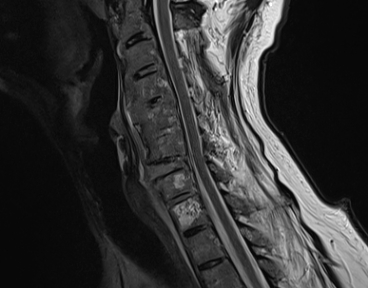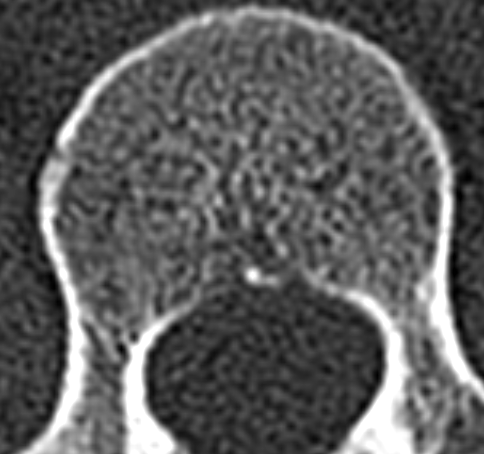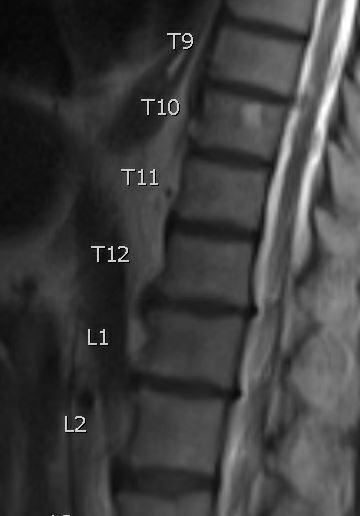Introduction
Spinal hemangiomas are the most common primary tumor of the spine.[1] Usually benign, this lesion is of vascular origin and like hemangiomas in other parts of the body usually involves a proliferation of normal capillary and venous structures.[2] According to one study, they have been identified in about 11% of patients at general autopsy.[3] These lesions are usually an incidental finding often found on CT and MR imaging of the body and spine, and frequently in radiographs of the thoracolumbar spine.[4] A minority of these lesions can be associated with symptoms, primarily involving back pain and neurologic complaints with some estimates of 0.9% to 1.2% becoming symptomatic.[5] Symptoms can involve severe back pain worsened by movement; however, mild to moderate pain can also be a presenting complaint.[6] In cases of neurogenic pain, hemangiomas usually extend into the spinal canal or neural foramina.[7]
Etiology
Register For Free And Read The Full Article
Search engine and full access to all medical articles
10 free questions in your specialty
Free CME/CE Activities
Free daily question in your email
Save favorite articles to your dashboard
Emails offering discounts
Learn more about a Subscription to StatPearls Point-of-Care
Etiology
Although the exact etiology and inciting factor of spinal hemangiomas genesis are not well understood, a well-known characteristic of these benign lesions includes a vascular proliferation of capillaries similar to hemangiomas in other parts of the body. Proliferation subsequently causes a displacement of bone and in rarer cases erosion into the spinal canal. Unlike infantile hemangiomas, hemangiomas of the spine do not spontaneously regress.
Epidemiology
The incidence of spinal hemangiomas has been reported as 11% in autopsy studies.[3] Most are incidentally noted and can be characterized on radiographs of the spine as well as cross-sectional imaging. Females are somewhat more affected than males.[8] Incidence has also been reported on MRI studies as high as 27%.[8]
Histopathology
Grossly specimens can show periosteal elevation. Two histologic types of hemangiomas of the vertebra can occur cavernous and capillary angiomas. Cavernous angiomas involve large blood vessels not separated by normal bone. Capillary angiomas involve thin-walled capillary vessels separated by normal bone. There is usually a capsule surrounding the lesion with adjacent bone potentially exhibiting osteolysis.[9]
History and Physical
The primary goal of a thorough history and physical is 2-fold in the setting of symptomatic hemangioma. A clinician must rule out more concerning etiologies and assessment of the patient’s health status in the setting of a planned intervention.
Patient’s can often present with back pain, and a history of a previous incidentally-noted hemangioma should not misdirect a clinician from thoroughly evaluating more concerning etiologies of back pain including, but not limited, to metastasis, infection, primary malignancies of the spinal cord, as well as osteoporotic compression fractures. History taking should include onset, exacerbating and relieving factors, the intensity of pain, quality of pain, and radiation that could suggest radiculopathy. Hemangiomas tend to present in the thoracic spine and can present with pain in one location. Complaints of multiple sites of pain should raise a clinician’s suspicion for metastatic lesions. More importantly, secondary symptoms play an important role, especially in the setting of suspected metastasis. A thorough history, including but not limited to, gastrointestinal and genitourinary review of systems questions should be elicited. Pain referred to the back from other areas of the body, a known history of cancer, history of trauma, history of osteoporosis, and pain that does not improve on lying down and resting should warrant further evaluation including, but not limited to, additional imaging.
Physical examination primarily involves a thorough back examination that includes a visual inspection of the overlying skin, assessing the curvature of the spine, and observing gait. The range of motion should also be tested including forward flexion, extension, lateral flexion, and rotation. The spine should be palpated specifically at the patient-indicated site of pain. Percussion should be performed to assess for costovertebral tenderness. Considering hemangiomas can erode into the spinal canal, assessing for radiculopathy is important in the physical examination of the spine. Special maneuvers to asses for radiculopathy should be performed including the straight leg raise test for the lower back and the Spurling maneuver in the setting of cervical radiculopathy. Reflexes should be tested, and sensation with close attention to the thoracic dermatomes should be performed. Finally, the physical examination should include evaluation of the gastrointestinal and genitourinary systems.
Evaluation
The role of imaging is critical in the evaluation of a hemangioma including lesion size, site, and degree of lytic involvement of the spinal canal and neuroforamina. Radiograph usually shows a prominent trabecular pattern with vertical striations. The density of the vertebral body is often increased giving a sclerotic appearance. Vertebral body height and size should remain unaffected. On CT imaging, hemangiomas have a classic corduroy(accordion) pattern from coarsening of the trabeculae. Although rare, bone destruction and extension into the adjacent soft tissues including the spinal canal can be evaluated on CT imaging. MR imaging can definitively assess for soft-tissue extension.
Treatment / Management
Given that the vast majority of hemangiomas are asymptomatic and are a benign entity, treatment and intervention are usually not employed in asymptomatic patients. In the setting of symptomatic patients, different interventions have been used in their treatment. Endovascular embolization has been used to treat painful vertebral hemangiomas and has been shown to relieve spinal cord compression from epidural extension.[10] Percutaneous vertebroplasty has also been shown to be effective in pain relief.[11] Transpedicular ethanol injection has been employed in the treatment of spinal hemangiomas; however, complications have been seen.[12] Radiation therapy has also been used to treat painful lesions considering spinal hemangiomas are radiosensitive lesions.[13]
Differential Diagnosis
The differential diagnosis for sclerotic lesions of the spine is wide. Paget disease can be considered in the setting of a vertebral body lesion mimicking a hemangioma; however, cortical thickening is often present with a characteristic “picture frame sign.” Squaring of the vertebra can also be appreciated. Sclerotic metastasis such as in the setting of prostate carcinoma, osteosarcoma, and medullary thyroid carcinoma should also be considered in the differential. Other differentials include lymphoma and multiple myeloma.
Complications
Complications, although rare, can infrequently occur. Pathologic burst fracture can be problematic considering these highly vascular lesions can subsequently bleed causing a hematoma and resultant cord compression.[14] Epidural extension, although also rare, can occur leading to neurologic deficits in the setting of cord compression. Exiting nerve roots can also be affected leading to neurologic symptoms. Spontaneous epidural hemorrhage can also occur, although hemorrhage is usually an iatrogenic complication.
Consultations
- Pain medicine
- Orthopedics
- Neurosurgery
Deterrence and Patient Education
In the setting of a confirmed and asymptomatic hemangioma, a patient can be reassured that this is a benign entity. However, the patient should return to the clinic in the setting of pain or neurologic deficits of any kind. A thorough evaluation can then be performed to understand the etiology of the symptoms and to confirm whether the new onset of symptoms is secondary to a now symptomatic hemangioma or a different etiology.
Enhancing Healthcare Team Outcomes
Patients with symptomatic vertebral hemangiomas present to their primary care physician with either back pain or neurologic symptoms. In the setting of back pain, a coordinated approach between a primary care physician and a radiologist is important in understanding and identifying whether a vertebral hemangioma or another pathology is the pain generator during a specific complaint about back pain. In more severe cases of back pain, a physiatrist can play an important role in managing pain. In cases of neurologic symptoms, surgical intervention is often necessary, and a coordinated approach with a radiologist in identifying the degree of extension into the spinal cord or neural foramina is important.
Media
(Click Image to Enlarge)
References
Ciftdemir M, Kaya M, Selcuk E, Yalniz E. Tumors of the spine. World journal of orthopedics. 2016 Feb 18:7(2):109-16. doi: 10.5312/wjo.v7.i2.109. Epub 2016 Feb 18 [PubMed PMID: 26925382]
Nair AP, Kumar R, Srivastav AK, Sahu RN, Kumar B. Outcome of dorsolumbar vertebral hemangiomas presenting with neuraxial compression. Indian journal of orthopaedics. 2012 Sep:46(5):536-41. doi: 10.4103/0019-5413.101033. Epub [PubMed PMID: 23162146]
Pastushyn AI, Slin'ko EI, Mirzoyeva GM. Vertebral hemangiomas: diagnosis, management, natural history and clinicopathological correlates in 86 patients. Surgical neurology. 1998 Dec:50(6):535-47 [PubMed PMID: 9870814]
Level 2 (mid-level) evidenceDang L, Liu C, Yang SM, Jiang L, Liu ZJ, Liu XG, Yuan HS, Wei F, Yu M. Aggressive vertebral hemangioma of the thoracic spine without typical radiological appearance. European spine journal : official publication of the European Spine Society, the European Spinal Deformity Society, and the European Section of the Cervical Spine Research Society. 2012 Oct:21(10):1994-9. doi: 10.1007/s00586-012-2349-1. Epub 2012 Jun 26 [PubMed PMID: 22732826]
Level 3 (low-level) evidenceNguyen JP, Djindjian M, Gaston A, Gherardi R, Benhaiem N, Caron JP, Poirier J. Vertebral hemangiomas presenting with neurologic symptoms. Surgical neurology. 1987 Apr:27(4):391-7 [PubMed PMID: 3824146]
Level 3 (low-level) evidenceLakemeier S, Westhoff CC, Fuchs-Winkelmann S, Schofer MD. Osseous hemangioma of the seventh cervical vertebra with osteoid formation mimicking metastasis: a case report. Journal of medical case reports. 2009 Nov 2:3():92. doi: 10.1186/1752-1947-3-92. Epub 2009 Nov 2 [PubMed PMID: 19946508]
Level 3 (low-level) evidenceVinay S, Khan SK, Braybrooke JR. Lumbar vertebral haemangioma causing pathological fracture, epidural haemorrhage, and cord compression: a case report and review of literature. The journal of spinal cord medicine. 2011:34(3):335-9. doi: 10.1179/2045772311Y.0000000004. Epub [PubMed PMID: 21756575]
Level 3 (low-level) evidenceBarzin M, Maleki I. Incidence of vertebral hemangioma on spinal magnetic resonance imaging in Northern Iran. Pakistan journal of biological sciences : PJBS. 2009 Mar 15:12(6):542-4 [PubMed PMID: 19580008]
Gray F, Gherardi R, Benhaiem-Sigaux N. [Vertebral hemangioma. Definition, limitations, anatomopathologic aspects]. Neuro-Chirurgie. 1989:35(5):267-9 [PubMed PMID: 2483579]
Jayakumar PN, Vasudev MK, Srikanth SG. Symptomatic vertebral haemangioma: endovascular treatment of 12 patients. Spinal cord. 1997 Sep:35(9):624-8 [PubMed PMID: 9300972]
Hao J, Hu Z. Percutaneous cement vertebroplasty in the treatment of symptomatic vertebral hemangiomas. Pain physician. 2012 Jan-Feb:15(1):43-9 [PubMed PMID: 22270737]
Doppman JL, Oldfield EH, Heiss JD. Symptomatic vertebral hemangiomas: treatment by means of direct intralesional injection of ethanol. Radiology. 2000 Feb:214(2):341-8 [PubMed PMID: 10671579]
Aich RK, Deb AR, Banerjee A, Karim R, Gupta P. Symptomatic vertebral hemangioma: treatment with radiotherapy. Journal of cancer research and therapeutics. 2010 Apr-Jun:6(2):199-203. doi: 10.4103/0973-1482.65248. Epub [PubMed PMID: 20622368]
Dobran M, Mancini F, Nasi D, Gladi M, Sisti S, Scerrati M. Surgical treatment of aggressive vertebral hemangioma causing progressive paraparesis. Annals of medicine and surgery (2012). 2018 Jan:25():17-20. doi: 10.1016/j.amsu.2017.12.001. Epub 2017 Dec 8 [PubMed PMID: 29326813]


